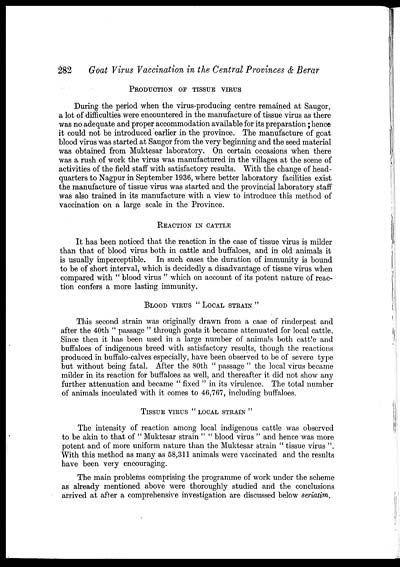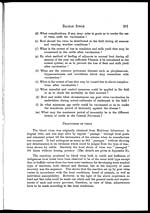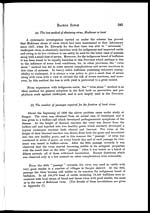Medicine - Veterinary > Veterinary colleges and laboratories > Indian journal of veterinary science and animal husbandry > Volume 9, 1939 > Original articles > Goat virus vaccination in the Central Provinces and Berar (final report)
(184) Page 282
Download files
Individual page:
Thumbnail gallery: Grid view | List view

282 Goat Virus Vaccination in the Central Provinces & Berar
PRODUCTION OF TISSUE VIRUS
During the period when the virus-producing centre remained at Saugor,
a lot of difficulties were encountered in the manufacture of tissue virus as there
was no adequate and proper accommodation available for its preparation; hence
it could not be introduced earlier in the province. The manufacture of goat
blood virus was started at Saugor from the very beginning and the seed material
was obtained from Muktesar laboratory. On certain occasions when there
was a rush of work the virus was manufactured in the villages at the scene of
activities of the field staff with satisfactory results. With the change of head-
quarters to Nagpur in September 1936, where better laboratory facilities exist
the manufacture of tissue virus was started and the provincial laboratory staff
was also trained in its manufacture with a view to introduce this method of
vaccination on a large scale in the Province.
REACTION IN CATTLE
It has been noticed that the reaction in the case of tissue virus is milder
than that of blood virus both in cattle and buffaloes, and in old animals it
is usually imperceptible. In such cases the duration of immunity is bound
to be of short interval, which is decidedly a disadvantage of tissue virus when
compared with " blood virus " which on account of its potent nature of reac-
tion confers a more lasting immunity.
BLOOD VIRUS " LOCAL STRAIN "
This second strain was originally drawn from a case of rinderpest and
after the 40th " passage " through goats it became attenuated for local cattle.
Since then it has been used in a large number of animals both cattle and
buffaloes of indigenous breed with satisfactory results, though the reactions
produced in buffalo-calves especially, have been observed to be of severe type
but without being fatal. After the 80th " passage " the local virus became
milder in its reaction for buffaloes as well, and thereafter it did not show any
further attenuation and became " fixed " in its virulence. The total number
of animals inoculated with it comes to 46,767, including buffaloes.
TISSUE VIRUS " LOCAL STRAIN "
The intensity of reaction among local indigenous cattle was observed
to be akin to that of " Muktesar strain " " blood virus " and hence was more
potent and of more uniform nature than the Muktesar strain " tissue virus ".
With this method as many as 58,311 animals were vaccinated and the results
have been very encouraging.
The main problems comprising the programme of work under the scheme
as already mentioned above were thoroughly studied and the conclusions
arrived at after a comprehensive investigation are discussed below seriatim.
Set display mode to: Large image | Zoom image | Transcription
Images and transcriptions on this page, including medium image downloads, may be used under the Creative Commons Attribution 4.0 International Licence unless otherwise stated. ![]()
| Permanent URL | https://digital.nls.uk/75246988 |
|---|
| Description | Covers articles from 1939. Please note that pagination starts at p.139 and plates at Plate V. |
|---|




